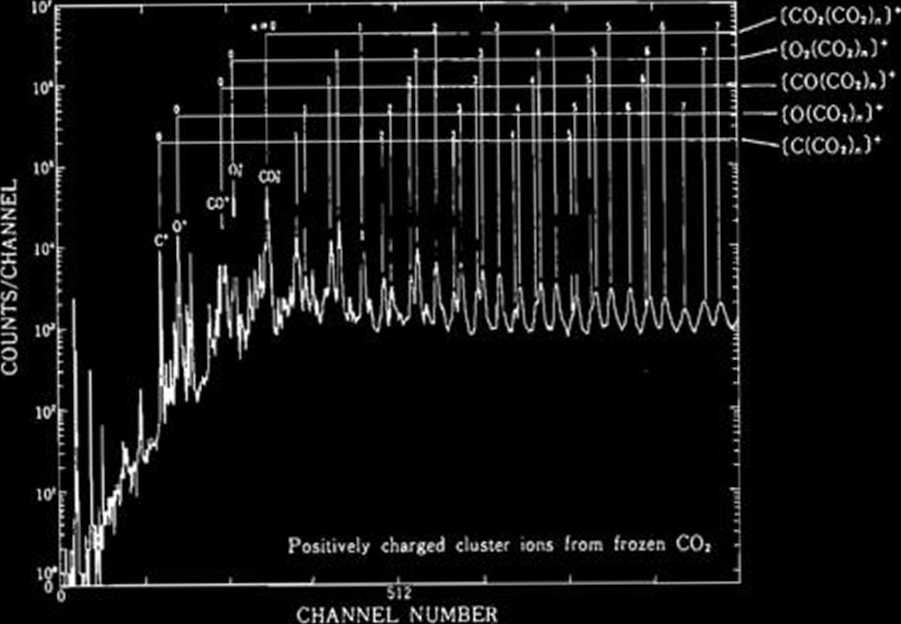372596240
53
RIKEN Accel. Próg. Rep. 24 (1990)
IM-2-19. Multiply Charged lons and Cluster lons Produced from Frozen Targets under Energetic Heavy lon Impact
H. Tawara, T. Tonuma, H. Kumagai, T. Matsuo, and H. Shibata
In the present work we have measured positive as well as negative ions produced under the impact of a few picoampere 60 MeV Arę+ (q = 4, 12, 13) ions provided from RIKEN linear acceler-ator on frozen gas targets. The target (molecu-lar) gases are frozen on thin foils cooled at the liquid nitrogen temperaturę. The gas pressure measured at a vacuum chamber wali is about (5-7) X10-7 Torr, with a background pressure of 1X1Q-7 Torr.

Fig. 1. A typical positive ion spectrum obtained from frozen C02 target under 60 MeV Ar4+ ion impact.
A typical example of positive ion spectra from a frozen C02 target is shown in Fig. 1. In addition to singly as well as multiply charged atomie ions and molecular ions, a variety of cluster ions are observed at fairly high intensities. These cluster ions are clearly formed from different core ions produced in preceding collisions with energetic heavy ions. In the present case, the following singly charged cluster ions are dominant: [C02 (C02)*]+, [C0(C02)n]+, [02(C02)*]+, [C (C02)*]+, and [0(C02) n]+. Surprisingly the most intense peak is found to be due to 02+ ions, which have never been observed in gaseous targets, followed by the cluster ions with 02+ ion core. In the frozen C02 targets, the 02+ ion is formed probably through recombination of 0+ ion with another O atom, both being the dissociation Products in the frozen target, during migration to the surface. It is also noted that the intensities of these cluster ions decrease smoothly with a little fluctuation as the number of molecules clustered around the core, n, inereases, but the “magie number” indicating cluster ions with special sta-bilities could be hardly observed. This is in con-trast to cluster ion produced in expanding gas targets.0
A similar sharp difference is also observed in the production of multiply charged ions: relative-ly intense peaks corresponding to 0I+ (z = 1-4) ions and even a tracę of 05+ ions are seen in a spectrum, meanwhile only very weak C2+ and practically no C3+ ions are observed. On the other hand, in a previous gaseous target spectrum,2) multiply charged carbon ions are morę intense by an order of magnitude than corresponding multiply charged oxygen ions.
A morę dramatic difference is seen in negative-ly charged cluster ion spectra. In the present frozen target experiment, most intense peaks correspond to O" and [0(C02)„]_ cluster ions, whereas only a series of [C02(C02) cluster ions are observed in expanding gas targets.3)
Similar measurements are under way for other frozen gas targets. Presently, the detailed production mechanisms and stabilities of ions involving cluster ions from frozen targets are not well understood, though the stabilities of the ions seem to be strongly influenced by the density of targets depending on gas or frozen phases.
It is concluded that the frozen targets can provide a variety of cluster ions as well as atomie and molecular ions, sharply different from those produced in gaseous targets, some of which have been observed only in space but not in laboratories.
References
1) O. Echt, K. Sattler, and E. Recknagel: Phys. Lełł., 90A, 185 (1982).
2) T. Matsuo, T. Tonuma, M. Kasę, T. Kambara, H. Kumagai, and H. Tawara: Chem. Phys., 121, 93 (1988).
3) M.L. Alexander, M.A. Johnson, N.E. Levinger, and W.C. Lineberger: Phys. Rev. Lett., 57, 976 (1986).
Wyszukiwarka
Podobne podstrony:
121 RIKEN Accel. Próg. Rep. 24 (1990)IM-5-23. A Test for SMART Neutron Detectors H. Orihara, K. Hata
121 RIKEN Accel. Próg. Rep. 24 (1990)IM-5-23. A Test for SMART Neutron Detectors H. Orihara, K. Hata
116 RIKEN Accel. Próg. Rep. 24 (1990)111-5-19. Responses of Large Position-Sensitive Detectorsto Hea
29 RIKEN Accel. Próg. Rep. 24 (1990)111-1-19. Dissociation Cross Sections of nLiK. Soutome, S. Yamaj
92 RIKEN Accel. Próg. Rep. 24 (1990)111-5. Instrumentation1. Design of a Microbeamline for a Compact
94 RIKEN Accel. Próg. Rep. 24 (1990)111-5-2. Design of a Decay Muon Channel Using an Axially Symmetr
102 RIKEN Accel Próg. Rep. 24 (1990)111-5-8. Performance of Isotopic Separation in RIPS T.Nakamura,
103 RIKEN Accel. Próg. Rep. 24 (1990)111-5-9. Test Experiment of the GARIS/IGISOL K. Morita, T. Nomu
105 RIKEN Accel. Próg. Rep. 24 (1990)111-5-10. Velocity Distribution of IGISOL lon Beams M. Koizumi,
108 RIKEN Accel. Próg. Rep. 24 (1990)111-5-12. Status Report of the RIKEN Swinger-Magnetic Analyzer
110 RIKEN Accel. Próg. Rep. 24 (1990)111-5-14. Test for Dispersive-Mode Beam Transportto the SMART
RIKEN Accel. Próg. Rep. 24 (1990)111-5-25. High Speed Serial Data Link for PC-9801 J. Fujita > PC
129 RIKEN Accel. Próg. Rep. 24 (1990)IV-2. Cross Section Data for 68Ge ProductionY. Tendow, A. Hashi
132 RIKEN Accel. Próg. Rep. 24 (1990)IV-5. Cross Sections Calculated by an ALICE Codęin the A = 50 —
133 RIKEN Accel. Próg. Rep. 24 (1990)V. DEVELOPMENT OF ACCELERATOR FACILITIES1. lon Accelerator Deve
138 RIKEN Accel. Próg. Rep. 24 (1990)V-l-4. RIKEN (Japan)-RAL (U.K.) Collaboration on Muon Science R
więcej podobnych podstron